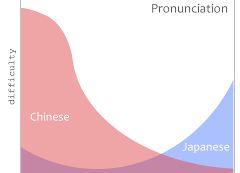The different learning curves of Chinese and Japanese
 I just came across John Pasden‘s ‘Learning Curves: Chinese vs. Japanese’ post.
I just came across John Pasden‘s ‘Learning Curves: Chinese vs. Japanese’ post.
The article uses two graphs to show that whilst Chinese and Japanese are both difficult to learn, the difficulty lies in very different areas and alters in different patterns as the learner makes progress.
John Pasden believes that in the early stages, Chinese pronunciation is immensely difficult for the learner. A combination of tones and very alien vowel and consonant sounds, plus explicit distinctions between sounds that most native English speakers consider the same, can entirely prevent the beginner from making themselves understood. Once tones have been mastered, however, the problem fades away.
Japanese pronunciation, on the other hand, poses far fewer problems in the early stages of learning. The tricky factor in learning this language, according to John Pasden, is the grammar. Learning Japanese grammar is a real mountain climb for beginners, but once the peak has been cleared it begins to get easier.
John Pasden finishes off the four-way comparison with Chinese grammar, which he says seems easy at first but steadily gets harder and harder throughout the learning career.
“Chinese grammar starts out fairly simple for English speakers. Some find it so simplistic that they say things like, “Chinese has no grammar.” This is not true, of course, and there are a few difficult points to master (like 了, which probably occupies a good chunk of the red area in the middle of the grammar graph), but overall, the grammar is not too rough.”
Whilst the article and its graphs are obviously a significant simplification, based on one person’s learning experiences, they are certainly worth checking out and do seem to ring true for many learners.
